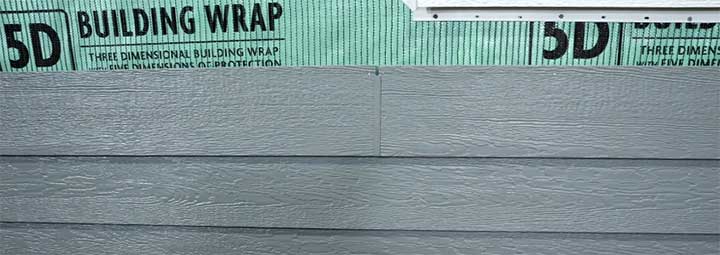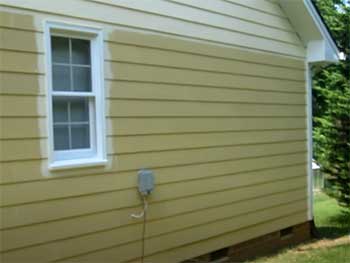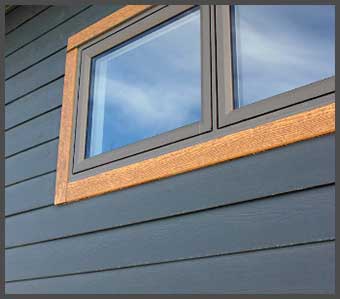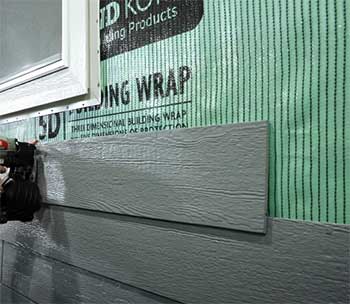So you’re looking to re-side your home and can’t decide between Diamond Kote and Hardie Board. Both are popular fiber cement sidings with some key differences.
In this comprehensive guide, we’ll compare the pros, cons, costs, and features of Diamond Kote and Hardie Board to help you make the best choice for your home’s exterior.
A Brief Comparison Table
| Feature | Diamond Kote | Hardie Board |
| Cost | $9-$11 per sq.ft installed | $6-$9 per sq.ft installed |
| Warranty | 50 years | 30 years |
| Expected Lifespan | 50-75 years | 40-50 years |
| Fire Resistance | 2100°F, non-combustible | Good but less than Diamond Kote |
| Impact Resistance | Excellent, very durable | Prone to dents |
| Wind Resistance | 160mph | 150mph |
| Water Resistance | Excellent, highly water-tight | Good, but less than Diamond Kote |
| Textures | Woodgrain, smooth | Woodgrain, smooth, stucco |
| Color Options | 20 standard colors | 100+ standard colors |
| Maintenance | Wash annually, repaint every 7-12 years | Wash annually, repaint every 7-12 years |
| Resale Value | Excellent, high-end look | Good, affordable look |
| Coastal Performance | Excellent, resists wind and water infiltration | Good, meets coastal codes |
| Wildfire Performance | Excellent, non-combustible | Good, fire resistant |
What Is Diamond Kote Siding?

Diamond Kote is a premium fiber cement siding product made by Nichiha. It consists of Portland cement, sand, cellulose fiber from recycled materials, and specialty additives. The siding panels are pressure-cured, making them dense and durable.
Here are some key facts about Diamond Kote:
- Made from fiber cement containing no formaldehyde
- Comes in a variety of textures and finishes
- Offers 50 year limited warranty
- Fire and impact resistant
- Resists rot, cracks and winds up to 160mph
Diamond Kote is available in traditional clapboard siding as well as shingle, vertical board and batten, and panel styles. It comes pre-primed and ready to paint or in a range of finished colors. The siding is 12 feet long but can be cut down for custom applications.
What Is Hardie Board Siding?
James Hardie is the largest manufacturer of fiber cement siding in North America. Their Hardie Board product is a popular fiber cement siding choice. Here are some quick facts:

- Made from sand, cement, and cellulose fiber
- Comes in smooth, woodgrain, and stucco textures
- Offers 30 year limited warranty
- Impact and fire resistant
- Resists moisture damage and rotting
Hardie Board comes as lap siding to mimic traditional wood clapboard.
It also comes as trim boards, soffit, fascia, and vertical siding.
Hardie Board siding is available primed or pre-finished in your choice of colors. The standard size is 12 feet long and can be cut down for custom siding projects.
Comparing the Pros and Cons of Diamond Kote And Hardie Board
Now that you know the basics of each type of siding, let’s compare some pros and cons to help you decide which is best for your exterior home remodel.
Diamond Kote Pros:
- Very durable and dent-resistant
- Longer warranty (50 yrs vs 30 yrs)
- Superior finish options like wood grain textures
- Stands up to hurricane force winds
- Resists fire up to 2100°F
Diamond Kote Cons:
- More expensive upfront cost
- Heavier than Hardie Board (2 lbs/sqft vs 1 lb/sqft)
- Fewer color options (20 standard colors)
Hardie Board Pros:
- Lower upfront cost
- Lighter weight than Diamond Kote
- More finish options (smooth, woodgrain, stucco)
- Comes with a color matching caulk
- Wide range of colors (100+ standard colors)
Hardie Board Cons:
- Prone to dents and scratches
- Shorter warranty period
- Not as fire or impact resistant as Diamond Kote
As you can see, Diamond Kote’s biggest advantages are its durability and longevity. It’s pound for pound a tougher, longer-lasting product. Hardie Board’s lighter weight and lower cost are its main pros.
Diamond Kote And Hardie Board Cost Comparison
Let’s break down the costs of both sidings. Pricing will vary somewhat by distributor, but here are some averages:
- Diamond Kote siding: $9-$11 per sq.ft
- Hardie Board siding: $6-$9 per sq.ft
So Diamond Kote generally costs $2-3 more per square foot. For a typical 2000 sq.ft home, that equates to $4000-$6000 more to install Diamond Kote siding.
However, Diamond Kote warrants their product for 50 years compared to Hardie Board’s 30 year warranty. The superior durability of Diamond Kote siding means it should outlast a Hardie Board install. So in the long run, it can actually be more cost effective despite the higher initial price.
Installation costs will be comparable between the two sidings. Make sure to get several installer bids before selecting a siding material. Their labor rates can factor heavily into the overall project cost.
How Long Does Each Type of Siding Last?
Fiber cement is highly durable, but Diamond Kote and Hardie Board have some differences in longevity.
- Diamond Kote siding warranty: 50 years
- Expected lifespan: 60-75 years
- Hardie Board siding warranty: 30 years
- Expected lifespan: 40-50 years
Diamond Kote warranties their siding for 20 years longer than Hardie Board. Independent tests also show it outlasting Hardie, confirming its superior durability.
Proper installation and regular cleaning/maintenance of any siding product will help maximize its lifespan. But all evidence points to Diamond Kote substantially outliving Hardie Board.
Appearance: Texture and Color Options
A home’s siding has a big impact on curb appeal. Let’s compare the available textures and colors of Diamond Kote vs. Hardie Board.
Diamond Kote Textures:
- Cedar: Realistic wood grain finish
- Essential: Smooth finish
- Rustic: Heavily grained wood texture
Hardie Board Textures:

- Smooth
- Woodgrain: Cedar grain pattern
- Stucco: Sandy, textured finish
Color Options:
- Diamond Kote: 20 standard colors
- Hardie Board: 100+ standard colors
As you can see, Hardie Board offers more standard textures and a wider selection of color options.
Diamond Kote’s 20 colors are popular, versatile choices but may entail custom matching.
Overall, Hardie Board provides a better range of colors and textures off the shelf. But Diamond Kote’s premium wood grain options deliver greater realism.
Which is Better in Rain, Fire, and Wind?
Durability matters, especially with extreme weather. Diamond Kote and Hardie Board both deliver excellent performance, but a few differences stand out:
Rain and Moisture:
- Diamond Kote and Hardie Board are both water-resistant and won’t rot.
- Diamond Kote is more watertight thanks to its tightly compressed panels.
Fire:
- Diamond Kote is non-combustible and fire-resistant to 2100°F.
- Hardie Board is also fire-resistant but starts to breakdown at lower temperatures.
Wind:
- Diamond Kote warrants wind resistance to speeds of up to 160 mph.
- Hardie Board is wind-resistant to 150 mph winds.
If you live in an area prone to hurricanes, heavy rain, or wildfires, Diamond Kote provides superior protection. Its extreme density and composition resist the elements better than Hardie Board.
Installation and Maintenance Requirements
Installing either siding properly is critical to getting the advertised durability. Let’s compare requirements:
Installation:
- Both require studs spaced 16″ on center or less
- Minimum 1 1/4″ corrosion resistant nails are needed
- Follow all manufacturer’s instructions carefully
Maintenance:
- Diamond Kote and Hardie Board should be washed annually
- Spot clean any stains/mildew as needed
- Repaint every 7-12 years based on paint finish
- Inspect for any cracks, damage, or loose nails
The install process is comparable for both sidings – the key is using an experienced installer. Proper maintenance is easy and important for both to maximize durability.
Diamond Kote And Hardie Board: Which is Best for Wildfire Prone Areas?
For homes in wildfire zones, fire safety is a priority. Fiber cement is inherently fire-resistant, but Diamond Kote’s dense composition gives it an advantage:
Diamond Kote
- Non-combustible and fire resistant to 2100°F
- Qualifies for use in all Wildland Urban Interface (WUI) zones
- Meets California SB-376 requirements for fire risk areas
- Can help reduce home insurance premiums in high risk zones
Hardie Board
- Class A fire rated and fire-resistant
- Meets code for WUI fire zones
- Doesn’t resist extreme heat as well as Diamond Kote
Overall, Diamond Kote is the smarter choice for fire prone areas. Its non-combustible panels don’t ignite or fuel fires. This added protection gives peace of mind and insurability in risky wildfire zones.
Which Is Better For Coastal Areas?
Homes near the ocean need siding that withstands salt spray, moisture, and hurricanes. Fiber cement excels in coastal environments, but Diamond Kote’s tight panel compression gives it an edge.
Diamond Kote
- Resists driving rain and ocean mist infiltration
- Won’t corrode or deteriorate from salt air
- Can withstand hurricane-force winds up to 160mph
- Meets the most stringent Florida and Miami Dade codes
Hardie Board
- Handles humidity and salt air exposure
- Resists winds up to 150 mph
- Meets coastal code requirements
Diamond Kote’s unparalleled density and compressed panels make it the best coastal siding. It stops water infiltration better while meeting the toughest wind codes.
What About Curb Appeal?
While durability matters most, aesthetics count too. Diamond Kote and Hardie Board both deliver attractive options for your home’s exterior.
Diamond Kote
- Realistic wood grain textures like Cedar
- Modern clean lines and lightly grained options
- Prefinished colors for immediate curb appeal
- More premium, upscale look
Hardie Board
- Smooth, stucco, and cedar woodgrain finishes
- Huge selection of colors
- Blended color and texture options
- Matches well with vinyl and wood trim
- More affordable style
Hardie Board’s wider range of colors and ability to mimic wood, stucco, and masonry make it versatile. Diamond Kote offers a higher-end look, especially with its Cedar grained finish.
Overall siding style and color impact curb appeal more than the material itself. Both products deliver attractive options that will boost your home’s exterior.
Which Is Easier To Install?
Fiber cement siding must be installed properly to get the desired durability. Both Diamond Kote and Hardie Board require meticulous installation for best results.
Here are some considerations:
- Must be installed on 16″ stud spacing or less
- Nailing patterns must be followed
- Joints and seams take skill to fit correctly
- Specialcuts require carbide blades
When done right, fiber cement installations last decades. The key is hiring competent installers who know the product. Don’t cut corners to save money on labor – poor installation can compromise the siding.
Diamond Kote and Hardie Board themselves install similarly. Diamond Kote weighs a little more, making it harder for installers to handle. Both require skill and carpentry experience for a quality installation.
Finding the Best Diamond Kote or Hardie Board Installers
Installation expertise makes or breaks a siding job. Here are tips for finding quality installers:
- Check reviews and ask to see past fiber cement projects
- Look for 5+ years experience installing it
- Ensure they follow all manufacturer’s instructions
- Ask about training credentials from the siding brand
- Get 3+ bids to compare cost and experience
- Verify they have all necessary insurance coverage
- Check that they warranty their labor
Don’t automatically choose the lowest bid – that can backfire with improper installation. Vet installers thoroughly and pay for quality workmanship.
Which is Better for Resale Value?
Use the right siding, and you’ll recoup more of the project cost when selling your home. Overall, fiber cement sidings like Diamond Kote and Hardie Board boost resale versus vinyl, wood, and other materials.
But Diamond Kote has a resale edge over Hardie Board:
Diamond Kote

- Premium curb appeal for a high-end look
- Highest fire, hurricane, and impact resistance
- Warranted to last 50 years
Hardie Board
- Affordable style to attract buyers
- Enhances value but not as durable
- Lower cost can help profits at sale
Diamond Kote’s upscale appearance and extreme durability help maximize resale profits.
Hardie Board is a good value boost too, but lacks Diamond Kote’s premium features.
Overall, fiber cement sidings recoup about 60-70% of replacement costs. Opt for Diamond Kote, and you can recoup more thanks to its sophisticated style and construction.
Is Diamond Kote Worth the Investment Over Hardie Board?
Diamond Kote costs more upfront but delivers:
- 2x the warranty (50 yrs vs 30 yrs)
- Superior fire, wind, and impact resistance
- Tighter finished panels that resist water better
- A premium woodgrain appearance for maximum curb appeal
- $4000-$6000 more installed for a typical home
If you want the best performing siding with maximum durability, Diamond Kote is worth the investment. You get what you pay for in terms of longevity, resilience, and looks.
For a more budget-friendly option, Hardie Board still performs well. It makes sense if you plan to sell in the near future. But serious long-term homeowners benefit more from Diamond Kote.
Frequently Asked Questions (FAQ)
Still have some questions? Here are answers to some common queries:
Diamond Kote is worth the investment if you want the very best in fiber cement performance and longevity. You pay more upfront but get a far superior 50 year warranty, fire/storm resistance, and premium aesthetics.
For a superior fiber cement alternative to Hardie Board, Diamond Kote is the best option. It offers comparable installation but with greater durability and longer warrantied performance.
Diamond Kote lasts 50-75 years when properly installed and maintained. The manufacturer warranties it for 50 years against defects. Expect 60+ years of performance from Diamond Kote thanks to its dense, resilient fiber cement.
Diamond Kote is a premium fiber cement siding made by Nichiha. Fiber cement contains cement, sand, cellulose fibers, and binders. It provides durability without wood’s maintenance needs.
The Bottom Line
Here’s the final takeaway on Diamond Kote vs. Hardie Board siding:
- Diamond Kote offers superior durability, fire resistance, and warranty coverage. It costs $2-3 more per square foot.
- Hardie Board is a quality fiber cement siding at a lower cost. It’s a good option if budget is a concern.
- For fire zones, coastal areas, and windy regions, Diamond Kote is worth the investment. It outperforms in extreme weather.
- Both install comparably. Proper fastening, joints, and spacing are critical.
- Maintenance is easy for both – wash and inspect annually, repaint every 7-12 years.
While Diamond Kote costs more upfront, you get what you pay for in exceptional performance and longevity. For a home you plan to live in long-term, it’s hard to beat Diamond Kote fiber cement siding.


Very good article, Ralph. Congrats. I’m specifically looking for the perm ratings for both products. I’m a Professional Designer and have been asked to replace what I’m currently recommending (Hardie Board) with Diamond Kote. I’m concerned that it may change where the dew point barrier is in the buildings. For the most part, we’re using Hardie Board in the gable ends of the structure, and that wouldn’t be a big deal. For the buildings we’re remodeling that have brick issues, we typically remove all the brick and replace it with Hardie Board. This may present a problem for the overall health of the building. If you could email me back, I would greatly appreciate it. Thanks so much, Sandy Jones